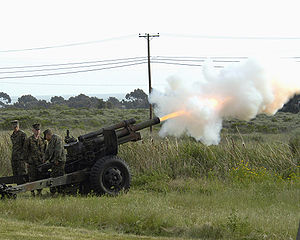| M101 105mm light howitzer, towed | |
|---|---|
 United States Marines fire a M101A1 during a ceremony in 2005 | |
| Type | Howitzer |
| Place of origin | United States |
| Service history | |
| In service | 1941–present |
| Wars | List of Conflicts
|
| Production history | |
| Manufacturer | Rock Island Arsenal Kia Machine Tool |
| Produced | 1941–1953 |
| No. built | 10,200 |
| Specifications | |
| Mass | 4,980 lb (2,260 kg) |
| Length | 19 ft 6 in (5.94 m) |
| Barrel length | 7 ft 7 in (2.31 m) L/22 |
| Width | 7 ft 3 in (2.21 m) |
| Height | 5 ft 8 in (1.73 m) |
| Shell | 105×372 mm R |
| Caliber | 105 mm (4.1 in) |
| Breech | Horizontal-block |
| Recoil | Hydro-pneumatic, constant, 42 in (110 cm) |
| Carriage | split trail |
| Elevation | −5° (−89 mils) to 65° (1,156 mils) |
| Traverse | ±23° (±409 mils) |
| Muzzle velocity | 1,550 ft/s (472 m/s) |
| Maximum firing range | 7.00 mi (11,270 m) |
The M101A1 (previously designated Howitzer M2A2 on Carriage M2A2) howitzer is an artillery piece developed and used by the United States. It was the standard U.S. light field howitzer in World War II and saw action in both the European and Pacific theaters and during the Korean War. Entering production in 1941, it quickly gained a reputation for accuracy and a powerful punch. The M101A1 fires 105 mm high explosive (HE) semi-fixed ammunition and has a range of 12,330 yards (11,270 m), making it suitable for supporting infantry.